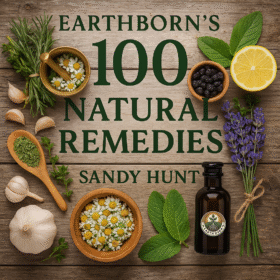
4 Medicinal Plants to Grow This Autumn in South Africa 🍂
Arthritis can be a painful and frustrating condition, but nature has provided us with incredible medicinal plants that help reduce inflammation and soothe aching joints. As we move into autumn in South Africa, now is the perfect time to plant herbs that thrive in cooler temperatures and will support natural joint relief.
By growing these four powerful medicinal plants, you can cultivate your own natural remedies while enjoying the benefits of organic, chemical-free healing. Let’s dive into the best arthritis-friendly plants to grow this season!
1️⃣ Cape Chamomile (Eriocephalus punctulatus) – A Calming Anti-Inflammatory
🔹 Why It Helps: This indigenous South African herb is known for its strong anti-inflammatory and pain-relieving properties. The essential oils in Cape Chamomile contain ester-rich compounds that help relax stiff joints, reduce swelling, and ease muscle pain—all common issues for those with arthritis.
🔹 How to Grow:
- Plant in autumn to early winter when temperatures are cooling.
- Prefers well-drained soil and full sun.
- Grows well in the Western Cape, Eastern Cape, and other Mediterranean-like climates.
- Drought-resistant once established, making it ideal for low-maintenance gardens.
🔹 How to Use:
- Oil infusion: The leaves and flowers can be infused into carrier oils like olive or coconut oil for topical joint massages.
- Tea: A mild Cape Chamomile tea can help relieve internal inflammation and promote relaxation and pain relief.
🌿 Garden Tip: Prune lightly in early spring to promote fresh growth and extend its blooming period.
2️⃣ Wild Rosemary (Eriocephalus africanus) – Circulation & Joint Pain Relief
🔹 Why It Helps: Often called Cape Snow Bush, Wild Rosemary is not only a culinary favorite but also a powerful anti-inflammatory and circulation booster. Poor circulation can worsen arthritis symptoms, leading to stiffness and pain. This herb helps improve blood flow to the joints, reducing discomfort.
🔹 How to Grow:
- Best planted in autumn to allow strong root establishment before winter.
- Prefers sandy, well-drained soil and thrives in full sun.
- Drought-tolerant once mature, making it perfect for water-wise gardens.
- Can be grown in the ground or in pots on patios and balconies.
🔹 How to Use:
- Tea: Brew fresh or dried Wild Rosemary leaves into a warming, anti-inflammatory tea to ease arthritis pain.
- Essential Oil: The fragrant oil can be used in aromatherapy or diluted with a carrier oil and applied to sore joints for relief.
🌿 Garden Tip: Trim regularly to encourage bushy growth and prevent it from becoming woody over time.
3️⃣ Nasturtium (Tropaeolum majus) – An Edible Anti-Inflammatory Powerhouse
🔹 Why It Helps: Nasturtium is a nutrient-packed, medicinal flower that is often overlooked as an arthritis remedy. Its high content of vitamin C, antioxidants, and sulfur compounds helps reduce inflammation, promote joint health, and support the immune system—important for autoimmune arthritis conditions.
🔹 How to Grow:
- Sow seeds in late summer to autumn for strong autumn and winter growth.
- Prefers full sun to partial shade and well-drained, moderately fertile soil.
- Nasturtium is self-seeding, meaning it will continue growing year after year if left undisturbed.
- Grows well in garden beds, hanging baskets, or containers.
🔹 How to Use:
- Fresh leaves & flowers: Add to salads, soups, and smoothies for an immune-boosting, joint-supporting nutritional boost.
- Tea: Brew into a mild tea to reduce inflammation and help manage arthritis pain from within.
🌿 Garden Tip: Nasturtium is a great companion plant for vegetables, deterring pests and improving soil quality.
4️⃣ Comfrey (Symphytum officinale) – The Ultimate Tissue Healer
🔹 Why It Helps: Comfrey is one of the most powerful healing plants for joint and bone-related conditions. It contains allantoin, which helps regenerate tissue, reduce swelling, and alleviate arthritis pain. Traditionally, comfrey has been used for healing bruises, sprains, and even fractures—making it a fantastic natural remedy for arthritis sufferers.
🔹 How to Grow:
- Best planted in autumn, as it establishes strong roots before winter.
- Prefers moist, fertile soil and partial to full sun.
- Hardy and drought-tolerant once mature, though it thrives with occasional watering.
- A perennial plant, meaning it will return year after year.
🔹 How to Use:
- Poultice: Fresh comfrey leaves can be crushed and applied directly to painful joints to reduce inflammation.
- Herbal Oil: Comfrey-infused oil can be used to massage aching areas, providing deep pain relief.
⚠️ Important Note: While comfrey is excellent for external use, it should not be taken internally due to alkaloids that may be harmful to the liver.
🌿 Garden Tip: Trim leaves regularly and allow some to decompose in the soil as a natural fertilizer.
🍂 Start Your Autumn Healing Garden Today!
Growing these four medicinal plants this autumn will not only provide you with organic, homegrown arthritis relief but will also enrich your garden with their beauty, fragrance, and healing properties. Whether you enjoy them as teas, oils, or poultices, these plants offer a natural way to reduce pain, support joint health, and promote mobility.
💬 Are you growing any of these healing herbs? Let us know in the comments!
#EarthBornGrower #HerbalHealing #ArthritisRelief #SouthAfricaGardening #AutumnGardening #MedicinalPlants 🌿🍂


 **Meet Sprout!** Sprout is your friendly gardening companion at Earthborn, always ready with helpful advice on plant care, medicinal herbs, and natural gardening solutions. From seedling to harvest, Sprout provides expert guidance to nurture your garden and your well-being—making gardening easy, fun, and naturally rewarding.
**Meet Sprout!** Sprout is your friendly gardening companion at Earthborn, always ready with helpful advice on plant care, medicinal herbs, and natural gardening solutions. From seedling to harvest, Sprout provides expert guidance to nurture your garden and your well-being—making gardening easy, fun, and naturally rewarding.
